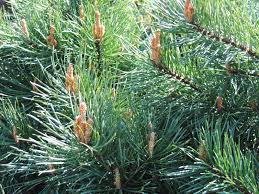COMPONENT COMPOSITION OF ESSENTIAL OIL OF PINE BUDS (PINUS SYLVESTRIS L.), GROWING IN THE URBAN ENVIRONMENT OF TOMSK REGION
Abstract
The component composition of pine buds essential oil, growing in the area of active economic activity in Tomsk region, has been studied. Essential oil from pine buds obtained by the method of distillation with the water steam.
The component composition of the essential oil was studied by gas-liquid-chromatography-mass spectrometry on the gas chromatograph Agilent 6890 with quadrupole mass spectrometer (HP MSD 5973N). Chromatography conditions: 30-meter long quartz column HP-5MS with internal diameter 0.25 mm, film thickness of 0.25 µm (copolymer 5% diphenyl 95% dimethylsiloxane), carrier gas – helium (constant flow 1 ml/min), column temperature – 50 °С (2 min isotherm), 50–200 °С (40 °C, min), 200–280 °С (20 °С/min), 280 °С (5 min isotherm), the temperature of the ion source 170 °С, the interface between the gas chromatograph and mass selective detector 280 °С. The energy of ionizing electrons is 70 eV. The volume of injected sample of 1 µl. The component composition was determined by comparing the times and linear retention indices, mass spectra values, the database of the chromatographic-mass spectrometric library of volatile substances of plant origin. About 163 individual components were found. It is established that with the increase of technogenic pollution, the amount of essential oil decreases, the component composition changes, which can serve as an indicator of the quality of raw materials, the state of the forest stand of pine and the environment as a whole.
Data on the dominant content of 3-caren in the composition of essential oils of the pine buds, growing in the Tomsk region, suggests a limited use of this raw material and essential oil on its basis in medical practice.
Downloads
Metrics
References
Gubanov I.A. i dr. Pinus sylvestris L. – Sosna obyknovennaya. Illyustrirovannyy opredelitel' rasteniy Sredney Rossii. T. 1. Paporotniki, khvoshchi, plauny, golosemennyye, pokrytosemennyye (odnodol'nyye). [Pinus sylvestris L. – Pine. Illus-trated determinant of plants in Central Russia. Vol. 1. Ferns, tails, moss, gymnosperms, angiosperms (monocots)]. Moscow, 2002, p. 120. (in Russ.).
Carlisle A., Brown A.H.F. J. Ecol., 1968, vol. 56, pр. 269–307.
Budantsev A.L., Lesiovskaya Ye.Ye. Dikorastushchiye poleznyye rasteniya Rossii. [Wild useful plants of Russia]. St. Petersburg, 2001, 663 p. (in Russ.).
Myasnikov A.G., Danchenko M.A. Sovremennyye problemy nauki i obrazovaniya, 2013, no. 6, p. 709. (in Russ.).
Narchuganov A.N., Strukova Ye.G., Yefremov A.A. Khimiya rastitel'nogo syr'ya, 2011, no. 4, pp. 103–108. (in Russ.).
Gosudarstvennaya Farmakopeya Rossiyskoy Federatsii XIII izdaniye. T. 3. [State Pharmacopoeia of the Russian Feder-ation XIII edition. Vol. 3.] [Electronic resource], URL: http://193.232.7.120/feml/clinical_ref/pharmacopoeia_3_html/HTML/#5/z (in Russ.).
Mashkovskiy M.D. Lekarstvennyye sredstva. [Medicines]. Moscow, 2017, 1216 p. (in Russ.).
Yefremov A.A., Strukova Ye.G., Narchuganov A.N. Zhurnal Sibirskogo federal'nogo universiteta. Khimiya, 2009, no. 4, pp. 335–350. (in Russ.).
Akimov Yu.A. Sostav i izmenchivost' efirnogo masla sosen yuga Ukrainy i perspektivy yego primeneniya: av-toref. dis. ... kand. biol. nauk. [The composition and variability of the essential oil of the pines of the south of Ukraine and the pro-spects for its use: av-toref. dis. ... Cand. biol. sciences]. Moscow, 1972, 13 p. (in Russ.).
Tereshkina O.I., Rudakova I.P., Samylina I.A. Farmatsiya, 2011, no. 7, pp. 1–14. (in Russ.).
Tereshkina O.I., Samylina I.A., Rudakova I.P., Gravel' I.V. Biomeditsina, 2011, no. 3, pp. 80–86. (in Russ.).
Gosudarstvennaya Farmakopeya Rossiyskoy Federatsii XIII izdaniye. T. 2. [State Pharmacopoeia of the Russian Feder-ation XIII edition. Vol. 2.] [Electronic resource], URL: http://193.232.7.120/feml/clinical_ref/pharmacopoeia_2_html/HTML/#5/z (in Russ.).
Tkachev A.V. Issledovaniye letuchikh veshchestv rasteniy. [Research on plant volatiles]. Novosibirsk, 2008, 969 p. (in Russ.).
Sotnikova O.V., Stepen' R.A. Khimiya rastitel'nogo syr'ya, 2001, no. 1, pp. 79–84. (in Russ.).
Judzentiene A., Stikliene A., Kupcinskiene E. The Scientific World Journal, 2007, vol. 7(S1), pр. 141–150.
Tsandekova O.L., Neverova O.A. Izvestiya Samarskogo nauchnogo tsentra Rossiyskoy akademii nauk, 2015, vol. 17, no. 4, pp. 226–231. (in Russ.).
Runova Ye.M. Vliyaniye tekhnogennogo zagryazneniya na sostoyaniye khvoynykh drevostoyev. [Influence of anthropo-genic pollution on the state of coniferous stands]. Krasnoyarsk, 1999, 56 p. (in Russ.).
Chzhan S.A. Osobennosti vliyaniya tekhnogennogo zagryazneniya na khvoynyye drevostoi. [Features of the impact of man-made pollution on coniferous stands]. Bratsk, 2010, 67 p. (in Russ.).
Neverova O.A., Tsandeova O.L., Domrachev D.V. Global journal of pharmacology, 2014, vol. 8(3), pр. 415–419.
Tikhonova I.V., Aniskina A.A., Mukhortova L.V., Loskutova S.R. Sibirskiy ekologicheskiy zhurnal, 2012, no. 3, pp. 397–405. (in Russ.).
Smelyanets V.P., Chursin L.A. Anz. Schaedlingsk. Pflanzenschutz, 1972, vol. 9, pр. 134–140.
Poltavchenko Yu.A. Efirnyye masla khvoynykh derev'yev Pribaykal'ya i genezis monoterpenov: avtoref. dis. … kand. khim. nauk. [Essential oils of coniferous trees of the Baikal region and the genesis of monoterpenes: author. dis. ... Cand. chemical sciences]. Irkutsk, 1974, 24 p. (in Russ.).


This work is licensed under a Creative Commons Attribution 4.0 International License.
The authors, which are published in this journal, agree to the following conditions:
1. Authors retain the copyright to the work and transfer to the journal the right of the first publication along with the work, at the same time licensing it under the terms of the Creative Commons Attribution License, which allows others to distribute this work with the obligatory indication of the authorship of this work and a link to the original publication in this journal .
2. The authors retain the right to enter into separate, additional contractual agreements for the non-exclusive distribution of the version of the work published by this journal (for example, to place it in the university depository or to publish it in a book), with reference to the original publication in this journal.
3. Authors are allowed to post their work on the Internet (for example, in a university repository or on their personal website) before and during the review process of this journal, as this may lead to a productive discussion, as well as more links to this published work.











